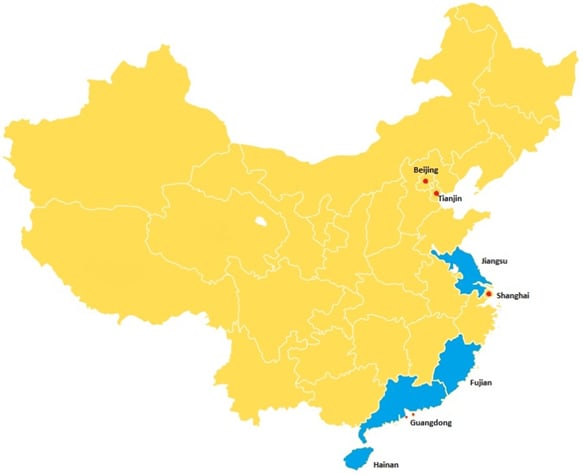China Launches Pilot Program to Further Open Up Its Health Care Industry
For a long period of time, China did not allow foreign investors to form wholly foreign-owned subsidiaries in China to operate medical institutions. This has now changed. On July 25, 2014, National Health and Family Planning Commission (NHFPC) and the Ministry of Commerce (MOFCOM) jointly promulgated a Notice on Launching Pilot Programs of Establishment of Wholly-foreign Owned Hospitals (Ref. Guo Wei Yi Han (2014) No. 244) (the "2014 Notice"), which permits wholly foreign-owned medical institutions to be set up in seven provinces and provincial-level cities and municipalities in the eastern part of China — Beijing, Shanghai, Tianjing, Jiangsu, Fujian, Guangdong and Hainan (location shown in the map immediately below) — on a pilot basis according to implementing rules to be adopted by each of these provinces and municipalities.

Background and Roadmap
Prior to the year 2000, most hospitals in China were government-funded public institutions, and the health care service industry was not accessible to either private investors or foreign investors.
In 2000, when China was negotiating to enter the World Trade Organization, China's Ministry of Foreign Trade and Economic Cooperation (the predecessor of MOFCOM) and Ministry of Health (the predecessor of the NHFPC) jointly promulgated the Interim Measures on the Administration of Sino-Foreign Equity and Cooperative Joint Venture Medical Institutions (the "2000 Measures") to allow foreign investors to set up either a Sino-foreign equity joint venture (EJV) or a Sino-foreign cooperative joint venture (CJV) medical institution, with foreign ownership of up to 70 percent.
In 2010, China's National Development and Reform Commission (NDRC), the Ministry of Health and other ministries jointly issued the Opinions on Further Encouraging and Guiding the Establishment of Medical Institutions by Social Capital (the "2010 Opinions"), which established a foundation for a gradual lifting of the cap on foreign equity stakes in EJV and CJV medical institutions. As a result, when NDRC and MOFCOM updated the Foreign Investment Industrial Guidance Catalogue in 2011, medical institutions were removed from the catalogue's "restricted" category and placed in a default "permitted" category.
However, prior to the 2014 Notice, foreign investors who desired to set up and operate a hospital or clinic in China were, with limited exceptions, still required to use an EJV or CJV for this purpose. In the limited exceptions, investors from Taiwan, Hong Kong and Macau were permitted to establish wholly foreign-owned medical institutions starting from December 2010, and foreign investors generally were permitted to establish them in the China (Shanghai) Pilot Free Trade Zone (Shanghai FTZ) starting from November 2013 (see the firm's update "Tentative measures for the Administration of Wholly Foreign-owned Medical Institutions in Shanghai Free Trade Zone" published in March 2014).
Consequently, the issuance of the 2014 Notice has been hailed as a significant development in the process of opening of this sector to foreign investors.
Highlights of the 2014 Notice
According to the 2014 Notice, foreign investors desiring to establish wholly foreign-owned medical institutions in China must satisfy certain qualification thresholds. They must be independent legal persons with direct or indirect experience in medical investment and management and meet one of the following requirements:
- Be able to provide internationally advanced managerial experience, management skills and service skills in managing medical institutions;
- Be able to provide internationally leading medical technologies and equipment; or
- Be able to complement or improve the local health care service capacity, medical treatment levels, medical technologies, funding and medical facilities.
These requirements are basically the same as those set out in the 2000 Measures for foreign investments in EJV or CJV medical institutions.
Another major development in the 2014 Notice is the delegation of approval authority for the establishment and on-going supervision of a wholly foreign-owned medical institution from the state-level NHFPC to its provincial branch. As is the case with the establishment of EJV or CJV medical institutions, a foreign investor needs to apply with the provincial-level branch of the NHFPC for approval and then proceed with the provincial-level branch of the MOFCOM for establishment formalities.
Unlike the 2000 Measures, the 2014 Notice does not require a minimum registered capital or total investment for a wholly foreign-owned medical institution. This may relate to the abolishment of minimum capitalization requirement under the newly amended Company Law promulgated on Dec. 28, 2013.
Implementation Rules to Follow
The 2014 Notice contains only broad-stroke rules for the approval of establishment and on-going supervision of wholly foreign-owned medical institutions. As is stated in the notice, the provincial-level branches of the NHFPC and MOFCOM are expected to promulgate implementing rules. However, it is our understanding that, as of the date of this writing, there are still no such rules. The local authorities in these pilot provinces and municipalities will likely need to consult with NHFPC to coordinate their approach and deal with several issues arising from conflicts between the 2014 Notice and the 2000 Measures, which remain in effect. In the absence of such rules, it is likely that local authorities will be reluctant to accept any applications for the establishment of wholly foreign-owned medical institutions, so industry practitioners may need to wait for this regulatory development to be borne out in practice. It is also possible that the rules may set out additional requirements for establishing a medical institution, which do not appear in the 2014 Notice, or that they will not be issued until the NHFPC amends the 2000 Measures.
Market Trend and Outlook
Foreign investors will continue to face significant challenges when investing in China's health care industry. Currently, Chinese mandatory insurance programs fail to provide sufficient insurance coverage to most residents of rural areas and unemployed residents (including children and retirees) of urban areas, and do not cover medical expenses charged by private or foreign-owned medical institutions. Most commercial insurance policies in China only provide coverages for major illness, and do not cover regular visits. More than 50 percent of the total health care costs in China are borne by Chinese residents themselves, which is a great burden for most Chinese residents. More importantly, the Chinese government only provides limited funding to medical institutions. It fixes doctors' service charges at public hospitals and clinics at a very low level, which had led many of them to seek additional revenue from sales of overprescribed drugs, medical devices and medical equipment and sometimes kickbacks or bribes from pharmaceutical and medical device companies and patients. Many industry insiders believe that comprehensive reforms are needed to facilitate the market entry and success of private and foreign investment in this sector.
However, the PRC health care industry is a sizable market that remains attractive to many foreign health care providers. Many of them are now exploring opportunities to enter into China's high-end health care market that is servicing the rapidly growing group of wealthy Chinese. After the regulations to allow wholly foreign-owned hospitals to be set up in Shanghai FTZ were adopted in late 2013, at least a dozen international medical and health providers (including medical schools of certain leading U.S. universities) have met with Shanghai FTZ authorities to discuss investments in the Shanghai FTZ. One example is the German-based Artemed Group, which recently entered into framework agreements to establish a wholly foreign-owned hospital with 100 beds in the Shanghai FTZ. We expect that, with the issuance of the 2014 Notice, there will be more foreign investors looking for opportunities to set up wholly foreign-owned hospitals in one or more of the pilot provinces and municipalities covered by the 2014 notice.
The material contained in this communication is informational, general in nature and does not constitute legal advice. The material contained in this communication should not be relied upon or used without consulting a lawyer to consider your specific circumstances. This communication was published on the date specified and may not include any changes in the topics, laws, rules or regulations covered. Receipt of this communication does not establish an attorney-client relationship. In some jurisdictions, this communication may be considered attorney advertising.


